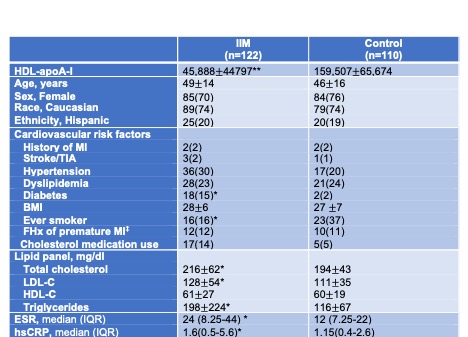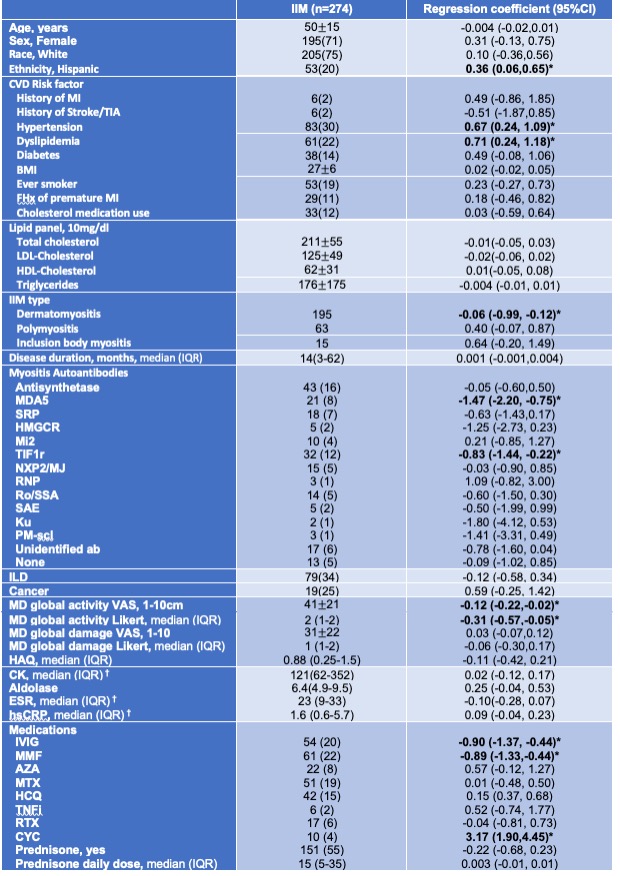Session Information
Session Type: Poster Session B
Session Time: 8:30AM-10:30AM
Background/Purpose: Patients with idiopathic inflammatory myopathies have accelerated vascular disease, which contributes to higher disease morbidity and mortality. Apolipoprotein A-I (apoA-I) is the major protein component of HDL, which suppresses vascular inflammatory responses through promotion of cholesterol efflux and prevention of low density lipoprotein (LDL) oxidation. The current work assessed HDL-associated ApoA-I levels (HDL-apoA-I) in IIM patients compared to healthy controls, and evaluated associations of HDL-apoA-I with specific IIM disease characteristics.
Methods: HDL-apoA-I levels were measured by sandwich ELISA using a primary HDL antibody. HDL-apoA-I levels, demographic variables and traditional cardiovascular risk factors were compared in 122 IIM patients and 110 healthy controls (HC). HDL-apoA-I levels were also assessed separately in a large IIM extended patient cohort (n=274) in relation to clinical and laboratory IIM disease characteristics. Multivariate linear regression analyses were performed to further assess predictors associated with HDL-apoA-I while adjusting for statistically significant univariate variables.
Results: HDL-apoA-I levels were significantly lower in IIM patients compared to HC (Table 1). The association between low HDL-apoA-I and IIM diagnosis remained strong after multivariate adjustment (Table 2). In linear regression analysis of the extended IIM patient group (Table 3), higher MD global disease activity scores by visual analog and likert scales as well as the presence of dermatomyositis (vs polymyositis or inclusion body myositis) and the presence of certain myositis specific autoantibodies (ab) (MDA5 and TIF1< ![if !msEquation] >< ![if !vml] >![]() < ![endif] >< ![endif] > ab) were associated with lower HLD-apoA-I levels. In multivariate analysis, the presence of MDA5 or TIF1γ ab remained significantly associated with lower HDL-apoA-I levels (regression coefficient β= -1.35, p< 0.001 and β= -0.81, p=0.01 respectively).
< ![endif] >< ![endif] > ab) were associated with lower HLD-apoA-I levels. In multivariate analysis, the presence of MDA5 or TIF1γ ab remained significantly associated with lower HDL-apoA-I levels (regression coefficient β= -1.35, p< 0.001 and β= -0.81, p=0.01 respectively).
Conclusion: HDL-apoA-I levels were significantly lower in IIM patients compared to HC, and inversely associated with the presence of MDA5 and TIF1γ ab. Our results indicate a potential mechanism for the microvascular inflammation and damage in IIM, particularly in patients with MDA5 and TIF1γ ab.
Values are mean±SD or N(%) unless specified
*P<0.05, **P<0.0001 by student’s t test and Wilcoxon rank sum test
‡Defined as first degree relative with MI at age <55 for male and <65 for female
Abbreviations: MI, myocardial infarction; TIA, transient ischemic attack; BMI, body mass index; FHx, family history; hsCRP, high sensitivity C-reactive protein
†Log transformation was used for skewed variables (apoA-I, hsCRP)
Values are mean±SD or N(%) unless specified
*p<0.05
† Log transformation was used for skewed variables to fit linearity assumption, apoA-I, CK, ESR, hsCRP
Abbreviations: MI, myocardial infarction; TIA, transient ischemic attack; BMI, body mass index; FHx, family history; VAS, visual analog scale; HAQ, health assessment questionnaire
To cite this abstract in AMA style:
Bae S, Shahbazian A, Wang J, Charles-Schoeman C. Suppression of HDL-associated Apolipoprotein A-I (apoA-I) Levels in Patients with Idiopathic Inflammatory Myopathies [abstract]. Arthritis Rheumatol. 2021; 73 (suppl 9). https://acrabstracts.org/abstract/suppression-of-hdl-associated-apolipoprotein-a-i-apoa-i-levels-in-patients-with-idiopathic-inflammatory-myopathies/. Accessed .« Back to ACR Convergence 2021
ACR Meeting Abstracts - https://acrabstracts.org/abstract/suppression-of-hdl-associated-apolipoprotein-a-i-apoa-i-levels-in-patients-with-idiopathic-inflammatory-myopathies/



